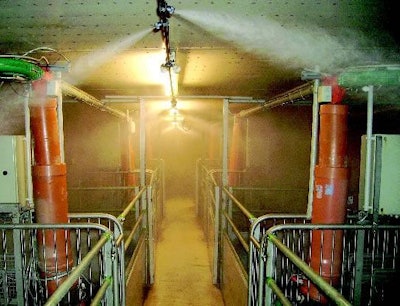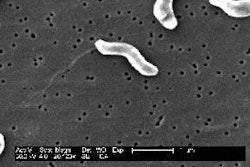
An unusual development can be reported from Germany. Farm insurance companies there have started to offer discounts of up to 50% on the annual premiums paid by pig units to insure against fire.
In Germany as anywhere else, insurers tend to be slow in cutting premium rates even when fire warning systems are installed. But the decision taken by the German insurance marketers this year relates to a system with a difference. Their discount is available only to units that fit a newly devised combination for fire detection and control.
Now installed on numerous units in northern Germany, this equipment has smoke detector devices that trigger an alarm in the usual way. Less usually, however, its activation would also start an automatic fogging sequence of water droplets for efficient fire control in the pig housing.
The installation came into existence after German engineers visited Norway and noted that smoke detectors were usually mandatory in Norwegian livestock barns. They decided the idea was good in principle and could be even better if a smoke alarm and fogging were installed together and linked by computer.
The concept since tested extensively in 2005 and 2006 by barn climate control specialist Schulz Systemtechnik from northern Germany is branded as Safe-n-Cool and features computer-controlled fogging that is married to highly sensitive smoke detection. The company highlights that smoke usually is detectable long before a fire actually breaks out, so it offers the ideal target for an early warning arrangement. The difficulty until now, however, has been in finding a reliable method of detection.
Although conventional smoke-detector systems have been around for many years, they have had a chequered career in all livestock buildings and especially in pig housing. The levels of dust, moisture and gases such as ammonia present in some houses may fool the sensor into giving a false alarm by reacting as if to smoke. In extreme cases the device can even become completely blocked after just a short while in operation.
To address such difficulties, the developers have employed a method of collecting air from various parts of the barn and channelling it to a central analysis point. It is claimed to allow a more sensitive setting of the detection system. Smoke particles in the air are detected reliably. The particle-based identification system therefore activates alarms soon after smouldering starts.
Of course, it would be possible to fit straightforward heat sensors and thus avoid the need for air analysing. However, as Beate Wendel from Schulz points out, these react only when a fire has actually broken out. The company's preferred approach allows the situation to be recognised quickly and controlled with immediate dousing from the fogging system before a full-scale conflagration occurs, in time to stop livestock injury or death through suffocation or smoke inhalation.
Also, Beate Wendel adds, the force of the water is comparatively gentle when emitted from fogging nozzles operated at a pressure of 20-50 bar. Fire hot-spots are therefore controlled without the extensive water damage often associated with sprinklers, hoses and other conventional fire-fighting methods. PIGI

















